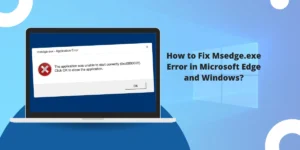What Does Windows Defender Security Warning Mean?
The Windows Defender security warning is an alert from the built-in anti-virus software in Windows indicating that it has detected a potential threat on your computer. Defender is enabled by default in Windows 10 and 11 to help protect against malware, viruses, and other security risks. This article provides an overview of the Windows Defender security warning, what triggers it, how to respond, and tips for preventing threats that set it off.
Key Takeaways
- The Windows Defender security warning appears when the anti-virus detects a potential threat like malware or a suspicious program.
- It does not necessarily mean your computer is infected, but that Defender has flagged something it deems potentially harmful.
- You can view details about the threat and take recommended actions like removing detected files or allowing exclusions.
- Defender warnings can be triggered by actual threats but also false positives and harmless files like software installers.
- Keeping Windows and Defender updated, being cautious of downloads, and running regular scans can help avoid many triggers.
What Triggers the Windows Defender Security Warning?
The Windows Defender security alert pops up on your screen when its scanning and monitoring detects any programs or activities that appear potentially malicious or harmful. Some of the primary triggers include:
- Malware Detection: Malware refers to malicious software like viruses, spyware, ransomware, and trojans that can infect your system and cause damage or steal your data. Defender scans files and memory for signatures and behaviors associated with known malware.
- Suspicious Programs: In addition to known threats, Defender also flags any programs that exhibit suspicious behaviors, actions, or code that raises red flags. This may include lesser-known malware, hacking tools, or unsafe programs.
- Exploits: Exploits take advantage of vulnerabilities in software or operating systems to spread malware or gain unauthorized access. Defender watches for files trying to leverage exploits, like those distributed via phishing emails.
- Suspicious Network Traffic: The anti-virus inspects incoming and outgoing network traffic for connections, downloads, or communication that resemble malicious activity. Unexpected or spoofed IP addresses may also trigger warnings.
- Altered System Settings: Malware often alters registry settings, system configurations, and other aspects of Windows to disable security tools or spread infection. Defender detects and reverses these types of changes.
- Suspicious Files: New, renamed, modified, or uncommon file types that look potentially threatening may set off Defender scans when accessed. This includes files connected to unsafe websites or those associated with infection.
- False Positives: In some cases, the Defender may flag legitimate programs, files, or activities as suspicious in error. These false positives happen when something shares traits with malware but is actually harmless.
How to View Details About the Windows Defender Warning
When Windows Defender displays its security warning, you can view additional details about the perceived threat by following these steps:
- Open the Windows Defender Security Center app via the Start menu, system tray icon, or Control Panel.
- Go to the Virus & Threat Protection section.
- Look for active threat detections under Current threats.
- Click on the detection to expand details like the file name, location, perceived threat type, and number of instances found.
- Use the “Take action” buttons to allow, block, remove, or exclude the perceived threat as recommended.
- Click “Full history” to see the complete list of past Defender actions and blocked threats.
- Under Protection history, expand items to view when various protection features like virus scans were last run and anything found.
These steps provide more insight into what specifically triggered the security alert, the nature of the threat, and options for responding appropriately.
How to Address the Windows Defender Security Warning
When you get a Windows Defender warning, here are some steps to take in response:
- Don’t panic: The warning does not necessarily mean your system is infected or in danger. Defender often flags minor threats, false positives, or otherwise harmless files.
- Review details: Check the description and recommendations in Defender to gauge the actual severity and determine the following actions.
- Quarantine or remove threats: If a file or program is clearly malicious, allow Defender to move it to quarantine or obliterate it.
- Run a full scan: Do a manual full virus and threat scan of your system to uncover any other traces of infection.
- Restore system: If faced with a severe malware threat, use System Restore to roll back your PC state before the infection occurs.
- Exclude false positives: For valid programs incorrectly flagged, exclude them from future Defender scans to prevent repeat false alarms.
- Update Windows and Defender: Install the latest security definition updates so Defender can detect emerging threats.
- Limit exposure: Avoid downloading random files and programs, stick to trusted sites, and don’t open suspicious emails or attachments.
- Use additional protection: Consider adding another anti-virus tool for a second opinion to Defender’s scanning.
Tips to Remove Windows Defender Security Warning Scam
Here are some general tips to improve security and reduce the chances of seeing false or excessive Windows Defender security alerts:
- Install all Windows and Defender updates promptly. These contain fixes for vulnerabilities and the latest threat definitions.
- Only download software from official publisher sites you trust to avoid malware bundles.
- Don’t open email attachments or click links from strangers, as they commonly distribute exploits and infected files.
- Make regular backups of essential data to minimize reliance on any compromised system.
- Use strong passwords and limit administrator accounts to prevent malware or intruders from making changes.
- Don’t plug in external media like USB drives from untrusted sources that may contain hidden malware.
- Run periodic full anti-virus scans to catch any threats that initially slipped through unnoticed.
- Limit the use of unfamiliar tools and programs that may act suspiciously to Defender.
- Review auto-run settings to prevent unknown programs from installing or executing code automatically.
- Research unfamiliar files and programs flagged before excluding them to ensure they are safe.
- Enable firewalls, anti-exploit features, and other security layers in addition to Defender for in-depth defense.
- Practice safe browsing habits and avoid clearly suspicious or insecure websites prone to malware.
Conclusion
The Windows Defender security warning should not be ignored as it indicates your system detected some form of potential threat. Carefully review the details to determine the severity, whether any response is required, and steps to prevent similar warnings in the future. While Defender can generate false positives, it often catches actual malware and exploits warrant removal. Use the notification as a prompt to verify your system’s security is up to date and adequately protected overall.
FAQs on Windows Defender Security Warning Scam
Does a Windows Defender warning mean my computer is infected?
Not necessarily. The Defender warning indicates it detected something suspicious, but it could be a false positive or low-threat item. You need to review the details to determine if there is a severe security risk.
Why does Defender sometimes detect false positives?
Defender uses aggressive heuristics to identify potential threats. Occasionally, these match harmless files or activity, leading to false positives. As Defender learns, Microsoft updates its definitions to reduce false flags.
Can I still use a program if Defender warns about it?
You can “Allow” a flagged program to run after reviewing it first. But exercise caution with unfamiliar software Defender warns about as it likely poses some security risk if triggered.
How do I know if the Defender warning is for a severe threat?
Check the type of threat and number of instances flagged. Descriptions like “severe”, “Trojan”, or “widespread infection” indicate highly malicious threats versus minor detections labeled “potentially unwanted app”.
Does turning off Windows Defender increase security risks?
Yes, disabling Defender removes a critical line of defense against viruses, malware, exploits, and other threats. You should only turn it off temporarily if you absolutely need to install another anti-virus program.
How often should I run a full Windows Defender scan?
Microsoft recommends performing a manual full system scan with Defender at least once a month. For added security against emerging threats, more frequent scans, like weekly or bi-weekly, are preferable.
Can I recover files quarantined by Defender?
The Defender quarantines suspicious files but does not delete them immediately so they can be recovered if they are determined to be safe and restore needed data. However, exercise caution when restoring quarantined files.

Priya Mervana
 Verified Web Security Experts
Verified Web Security Experts
Priya Mervana is working at SSLInsights.com as a web security expert with over 10 years of experience writing about encryption, SSL certificates, and online privacy. She aims to make complex security topics easily understandable for everyday internet users.


